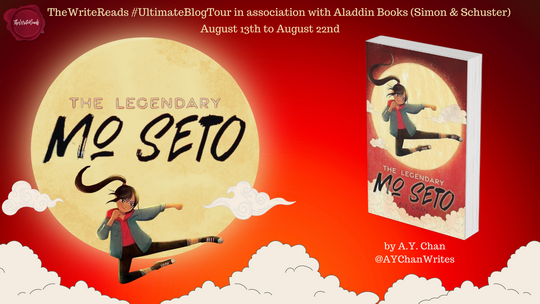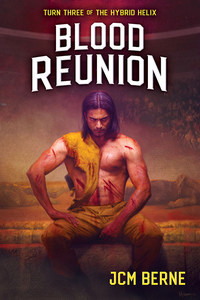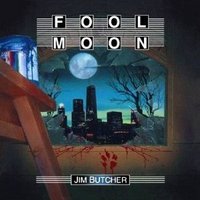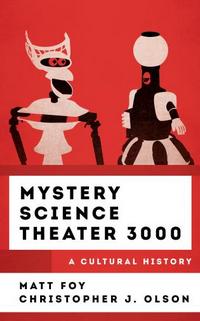 The Legendary Mo Seto
The Legendary Mo Seto
by A. Y. Chan
DETAILS: Series: The Legendary Mo Seto, #1 Publisher: Aladdin Paperbacks Publication Date: June 4, 2024 Format: Hardcover Length: 309 pg. Read Date: August 8-10, 2024

What’s The Legendary Mo Seto About?
This is one of those books that I could easily tell you everything in my enthusiasm, but that’d take away the need for you to read the book—and Chan’s much more entertaining than I could be. So, I’ll try to keep it to the essentials.
Modesty (please call her Mo) Seto is a devoted student of taekwondo and has been competing—and dominating—in competitions for years. But a fellow student recently hit a growth spurt that passed Mo by and he has started to beat her in competitions. This is getting to her, it’s just not fair. After coming in second to him (again), she sees a call for open auditions for people in her age range for a role in an upcoming martial arts movie starring her favorite movie star/martial artist in the world.
Technically, Mo is too short for their requirements—the height issue again, will she ever just grow? She comes up with a cunning plan* to get into the auditions anyway with the help of her best friend and his grandfather posing as her guardian. Why a faux grandfather? There’s no way that her mother would allow her to do anything like this and her father is away on a sudden business trip and isn’t communicating with Mo or her mother the way he usually would.
* Slightly more elaborate than anything Clark Kent has tried, and just as believable. Just roll with it.
We follow Mo through the audition process—which starts to take on unexpected peril as the set becomes plagued by threats and unexpected problems—possibly caused by sabotage. Oh, yeah, and her classmate/rival is also going up for the part.
Can Mo get the part without the truth being discovered? Will Mo be disillusioned by seeing behind the Movie Magic? Will Mo’s dad start responding to her? And what’s up with this old book with a little-known martial arts form Mo just found in her basement? More importantly, can she use any of it to her advantage?
The BTS Stuff
Let’s get this out of the way: This is an MG Novel, not Cinéma vérité. There’s no way that the auditions can work the way portrayed in the novel—especially when it comes to kids. It is impossible that any of Mo’s antics and hijinks to get her into—much less stay in—the auditions would work. If you’re looking for accuracy and an honest look at making martial arts movies with actors under 18, look elsewhere.
That said, there’s enough of a flavor of Hollywood to all of this to work. The attitudes of the casting people—the shallowness of the initial assessments, the stress of the director, the attitude toward the fight choreographer/stunt professionals, and so on—really feel like what you expect. They’re entertaining enough that you really don’t care how realistic things might be, too—feeling about right is good enough.
For my money, the best part of this is watching Cody Kwok in action and how everyone reacts to him. Kwok is a Jackie Chan-esque figure (only younger). He’s known for doing his own stunts—many of which are just incredible—as well as not being tied down to any one genre (but making them all, eventually, about martial arts). Kwok, his entourage, and the film’s executives know what they’re doing when it comes to preserving his image and promoting it, and the auditioning kids (and media) see exactly what they’re supposed to. Chan does an excellent job portraying both that and showing the reader that the Superstar’s image might not really be the truth.
Characters Who Aren’t Mo
There’s a really strong cast of supporting characters who are as engaging as you want, I want to touch on just a few of them because it’d be too easy just to talk about Mo, and that’s not giving Chan’s work the credit it needs.
Mo’s rivals in the auditions are largely bullies when it comes to Mo (and some of the others), but they’re not all that bad. They’re just adolescent twerps who are probably covering up insecurities (well, a couple of them are entitled jerks who are on their way to being 80s movie villains)—the way they treat Mo is bad enough so you don’t make the mistake of liking them, can root for Mo against them, but you’re not going to worry about what they’ll do to her.
On the other hand, you get Mo’s friends who just make you like her more—if someone as cool as Nacho (real name, Ignacio) is her best friend, she must be pretty cool herself. And Nacho is cool—he’s supportive, understanding, artistic, and nerdy in all the ways that Mo isn’t. Mo’s a little too hyper-focused on herself at the moment, but Nacho gets it and is willing to wait for her.
His grandfather is a hoot. Gramps is an honorary grandparent to Mo, as well as Nacho’s actual grandfather. He’s recently widowed and lonely, but he hasn’t let it get him down—at least not in front of the kids. He’s a loving and goofy character who really comes through for Nacho and Mo—he’s the kind of grandfather I’d like to be.
One of the auditioners who befriends Mo is named Sanjay. I hope they find a way to bring him back for the rest of the books in the series. He’s apparently pretty good at karate and is as gregarious as the others are antagonistic. He’s one of those kids who cannot stop talking once he starts and is not self-aware enough to realize he’s doing it or how people react to him. He’d probably be pretty annoying in real life but as a comic relief character? He’s great.
Lastly—Mo’s parents. Parents in MG novels are so tricky to get right (I’ve often thought), and Chan gets it right. Not just the characters, but how they treat Mo—and how Mo sees them and how they treat her. Mo’s dad introduced her to taekwondo and Cody Kwok. He’s her biggest fan and source of encouragement—he also pushes her (generally) in the way she needs to keep going. When he’s not there, the impact on Mo’s confidence and emotions cannot be overstated.
Things are complicated with her mother. Mom comes close to being a stereotype, at least the way the narration describes her. But I’m not sure she is, essentially they don’t get each other—from Mo’s perspective, her Mom doesn’t like who Mo is. She doesn’t want a daughter into taekwondo (especially not to the near-obsessive level Mo is), but would rather she pursued something more acceptable, like dancing and Chinese immersion camp, a dainty academic superstar in the waiting. The reader will see that Mo’s not understanding her mother quite right, but there’s nothing malicious in it. It’s just a tricky mother/daughter dynamic (that appears to be starting to work itself out).
Mo Herself
In case I gave the wrong impression when I talked about Nacho, Mo is a cool person, but since we see the whole book from her point of view, it might seem biased. Mo is a confident, optimistic, go-getter. The fact that she’s probably not going to keep growing past her 4’9″ stature while everyone around her (especially Dax) is still growing, isn’t doing her esteem any favors. Her recent tournament loss is doing a number on her—she’s upset that Dax’s size puts her at a disadvantage and is ready to give up, but she’s also so determined that she just can’t. Chan portraying both competing impulses is a tricky proposition, but she pulls it off.
The chance to work with Kwok is the opportunity of a lifetime for Mo. She’s re-read his autobiography a few times (can quote portions of it), and has watched countless interviews—she knows him as well as anyone who hasn’t met him can (and as well as many people who have met him could). She’s such a superfan that it’s hard not to want to see a few Kwok movies yourself. When she describes one of his films, she always introduces it as “my favorite Cody Kwok movie”—it doesn’t matter which one she’s talking about. It’s a tiny touch, but I loved it. Her enthusiasm is infectious.
Actually, not just her enthusiasm for Kwok—but for everything. Her despondency is a little catching, too, and comes when it should. But her personality can’t stay down for long. She grows a lot over the course of the novel*—as she needs to, it’s the point of adolescence anyway. But she also has plenty of room to grow, and that’s easy to see, too. It’ll be fun watching that over the rest of the series.
* That’s growth in terms of character. Much to her chagrin, she’s as tall at the end of the summer as she was at the beginning.
So, what did I think about The Legendary Mo Seto?
I had about as much fun as is permitted by law while reading this.
Sure, it’s an MG book, so I’m a few decades older than the target audience. I guessed almost all of the big reveals (I think attentive MG readers will get most of them, too), I’m pretty sure I know how the next two books are going to go, and I rolled my eyes at some of the sillier aspects of the book. That’s not a problem with Chan’s writing—I think it means she hit her target. The fact that she was able to write for them while keeping an old guy like me entertained is to be commended.
This is a fast, engaging read that will entice readers from the jump and keep them turning pages (likely with a grin) almost as fast as Mo can dash around. Older readers will want to adopt Mo and Nacho as kid siblings (or false grandparents), and younger readers will want to be like Mo—and hang out with her friends. As good as the story and the writing are (and Chan’s subtle prose is deceptively easy)—readers are going to walk away from this book thinking primarily of this determined and brave girl, who will muster up whatever she has to in order to get a shot at her dreams.
I’m leaving things out that I should be saying, I know I am—but I can’t think of what they are at the moment. So be sure to see what other people on the Tour are saying. So let me just wrap up by saying that for the young or young-at-heart reader, this is a sure-fire win.

This post contains an affiliate link. If you purchase from it, I will get a small commission at no additional cost to you. As always, the opinions expressed are my own.
My thanks to The Write Reads for the invitation to participate in this tour and the materials (including the novel) they provided.





























